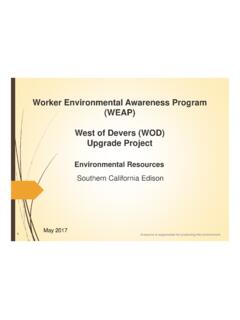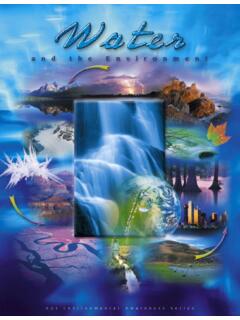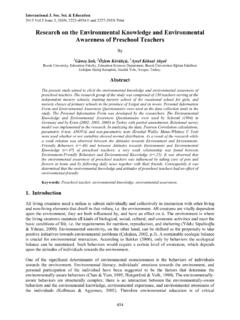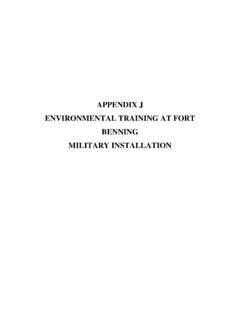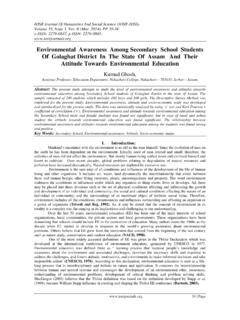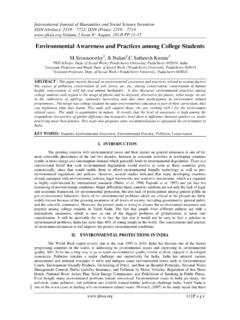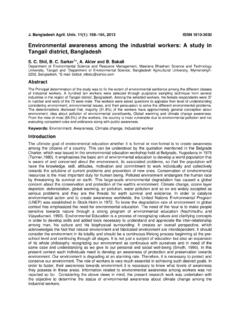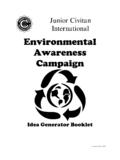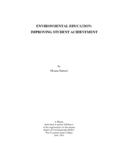Transcription of New Media Artists Promoting Environmental Awareness
1 Julie ColottiMSAE Candidate Teaching in New MediaSummer 2008 New Media Artists Promoting Environmental AwarenessArtists working in new Media are partnering with scientific researchers to raise public awarenessabout Environmental issues such as resource consumption and pollution. The aim of my paper is tohighlight the work of Ross Lovegrove (industrial 'green' designer), space Artists Tomas Saraceno ("FlyingGarden") and Richard Clar ("Collision 2"), Inigo Manglano-Ovalle ("Cloud Prototype No. 1" &"Iceberg"),and Brandon Ballengee (amphibian malformations) while discussing their connections and contributionsto the Environmental Art Movement and the conversation circling around sustainability. I will make adistinction between 'Eco-Art', 'Land-Art' and ' Environmental Art' while using these specified Artists as aplatform to discuss Environmental Artists working in new Media and their contributions to the visual arts.
2 Not only are these Artists creating ecologically relevant artwork, but they are also offering a dialog aboutthese issues and possible solutions for the great deal is being written and said about contemporary Artists and their abilityto critically discuss important questions of our time; holding a mirror to our modernsociety. In particular, some are using their artwork as a platform to address the currentglobal Environmental crisis. Brandon Ballengee, Inigo Manglano-Ovalle, Richard Clar,Tomas Saraceno, and Ross Lovegrove are all Artists that use hybrid practices of art,science, and technology to address ecological issues. These Media Artists are combiningart and technology to acknowledge our resource consumption (eco-footprints) and topromote sustainability. Each one is deeply rooted in the belief that art is nature andunderscores the impact that human activities have on our natural surroundings.
3 Eventhough their works acknowledge the devastation we are causing to our planet, they alsoseduce the audience into an unexpected interplay between natural order and analyzing the individual works of the afore-mentioned Artists , it would beappropriate to discuss Environmental art and how it aligns with the enormous field ofeco-art. At the virtual Green Museum there is aJulie Colotti1forum discussing these terms of eco-art, art in nature, land art, etc. stating that Environmental art is art that helps improve our relationship with the natural world while admitting that the definition itself is a work in progress as the discussion her paper entitled Environmental Awareness through Eco-visualization: CombiningArt and Technology to Promote Sustainability Tiffany Holmes defines eco-art as art ofall Media with an ecological theme but emphasizes that eco-art tends to focus onsingular works that occupy or reclaim a particular geography for a specific reason, suchas designing a park on a public landfill, (page 5).
4 She goes on to differentiate Environmental art from land art while addressing that both are subsets of the largerfield of eco-art . Land or earth Artists were coined in the late 1960s when they wanted tobreak the confines of the traditional gallery space and were concerned with usingmaterials from the natural world not to promote sustainability, but rather to feed anaesthetic curiosity based on a general appreciation for natural forms, (page 10). Anexample of a land artist is Andy Goldsworthy who photographs his ephemeral works innature. On one hand, an argument could be made that he is an Environmental artistbecause he recycles organic material into his work. However, on the other hand this is anindirect aspect of his process of understanding his private connection and discourse withthe natural world. His photographs document a private journey of self-discovery in thecontext of nature as opposed to raising Awareness to the urgency and importance ofrecycling.
5 Holmes stresses that in the intention of the piece lies the fundamentaldifference between land art and Environmental art; Environmental art is distinct from thefields of land art or earthworks due to its focus on creating work with a clear focus onissues of sustainability, (page 10). Therefore, Environmental art takes on a more activistJulie Colotti2approach and could stem from a variety of mediums in traditional or alternative publicexhibition spaces. Thus, for the reminder of this paper, I am limiting the discussion tofive new Media Artists who can be classified as Environmental Artists because pollutionand consumption are driving their scientific and artistic Standing at this intersection of research biology, conceptual art and activism isBrandon Ballengee whose work documents his persistent investigation into the rampantincrease in physical deformities among amphibians on our continent.
6 In his piece American Bullfrog with a Third Leg (1998) , Ballengee sheds light on the effects ofwater pollution on aquatic ecosystems. His high resolution scans of such mutations showthe public a pristine version of reality in our wetlands. The extra limbs sprouting onfrogs and toads are caused by an infestation of a waterborne parasite called disrupt the normal limb development in amphibians and favor tadpoles astheir hosts. An increased growth of algae in the wetlands due to excess nitrogen fromfertilizer run-off has led to increased populations effected by trematodes. Ballengee smutated creatures depict the disturbed equilibrium resulting from our human article from On Earth magazine states Ballengee hopes these strange and disturbingimages offer a new way of seeing, an opportunity to mediate on the complexities ofhuman interaction with the natural world.
7 The Shock of the New: The eerie beauty of Brandon Ballengee sphotographs makes us think harder about an ugly phenomenon . On Earth. (Spring 2006): 11(1).Ballengee is also considered to be an activist for hiswork on a database project that will broadcast frogdeformities and declining populations on the web. Hecurrently experiments with regressive breedingJulie Colotti3techniques to reclaim vanishing species in his work entitled Species Reclamation . Bybreeding amphibians and recreating species of extinct frogs, Ballengee s art is engaing ingenetics and biological revolutions. He also experiments with introducingphosphorescent pigments. The pigments cause his specimens to glow in the dark,indicating the root of the mutation dilemma among various species. In an art review bythe New York Times, Ballengee s work was described as being Earthbound Ballengee play(s) with notions of the planet transformed by humanarrogance.
8 Harrison, Helen A. ART REVIEWS; The Planet s Glories, and Some of Its Pains. The New York Times (Sept12, 1999): NA. In his photographs the juxtaposition between the beautiful and the grotesque isrevealed. The bright colors and pigments in the frogs are stunning, yet the extra limbs areevidence of the chaos and disruption our fertilizers are wreaking on the ecosystems inaquatic habitats. The natural order created by centuries of evolution and the species relationship with the environment is thrust out of balance by these external stimuli. Also concerned with the interplay of the beautiful and the grotesque is InigoManglano-Ovalle who looks towards natural phenomena and weather patterns as aplatform to discuss a broader definition of climate. In the series Art:21: Art in theTwenty-first Century Season 4 Manglano-Ovalle is featured for his work in the ecologythemed section and he asks, What s beautiful and what s monstrous, or are they sointertwined that you can t locate either one of them?
9 This becomes the ethical dilemma,with both artist and viewer trying to clarify where they stand, (90). His work CloudPrototype No. 1, 2003, was created by capturing a thunderstorm in three-dimensional databy the Department of Atmospheric Sciences at the University of Illinois, Champaign-Urbana. While viewing the data he selected the moment before the storm erupted,Julie Colotti4depicting the potential of an incredibly productive force that also has the implication ofbeing highly destructive. The titanium rendering of this cumulonimbus thundercloud wasmade by computerized machinery developed by the automotive industry for compactcars. When I make a beautiful cloud, I still want people to think of a was responding to ourquest to find weapons of massdestruction and our memory loss ofthe fact that we actually createdthem, (page 90).
10 Sollins, Marybeth ed. Art:21: Artin the Twenty-first Century Season 4. Abrams, NewYork: clouds appear again in hispiece La Tormenta which hangs ina building for Homeland Security. The storm system serves as a metaphor forimmigration waves and the turbulence upon their arrival. The two storm clouds echo theduality of hope and anxiety reflective in the people who pass through the building. Clouds are a metaphor for transience of an unfettered journey dream of displaced person promise of postmodern world without borders. Therefore, Manglano-Ovallereferences the term climate not only in a meteorological sense but also looking at ourcurrent sociopolitical economic atmospheres. Leslie, R. Inigo Manglano-Ovalle: Max Protetch Gallery. ArtNexus. (June/Aug 2003): 132(3). In general, climate is composed of permeable systems that affect other systems.
